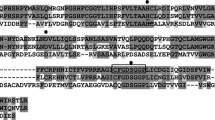Abstract
To elucidate the role of complement-mediated uptake in Leishmania major infection in vivo, transgenic BALB/c mice that express the cobra venom factor (CVF) under control of the α1-antitrypsin promoter were infected. CVF expression in these mice leads to a continuous activation and subsequent consumption of complement C3 in the serum. In contrast to susceptible non-transgenic BALB/c mice, CVF-transgenic mice are highly resistant to L. major infection and show a significantly reduced parasite dissemination. Transient depletion of C3 in wild-type BALB/c mice delays progression of lesions for some days. Both CVF-transgenic and non-transgenic mice exhibit similar T cell responses upon infection. However, in CVF-transgenic mice, no infiltration of neutrophils, which were the prominent infiltrating cells at the site of infection in normal susceptible mice, could be detected. We conclude that C3 cleavage is required for the attraction of neutrophils that participate in parasite dissemination.





Similar content being viewed by others
References
Titus RG, Theodosia CM, Shankar A, Hall LR (1993) Interactions between Leishmania major and macrophages. In: Zwilling T, Eisenstein T (eds) Macrophage-pathogen interactions. Marcel Dekker, New York, pp 437–459
Mosser DM, Brittingham A (1997). Leishmania, macrophages and complement: a tale of subversion and exploitation. Parasitology 115:S9–23
Mosser DM, Edelson PJ (1987). The third component of complement (C3) is responsible for the intracellular survival of Leishmania major. Nature 327:329–331
Da Silva RP, Hall BF, Joiner KA, Sacks DL (1989) CR1, the C3b receptor, mediates binding of infective Leishmania major metacyclic promastigotes to human macrophages. J Immunol 143:617–622
Guy RA, Belosevic M (1993) Comparison of receptors required for entry of Leishmania major amastigotes into macrophages. Infect Immun 61:1553–1558
Joshi PB, Kelly BL, Kamhawi S, Sacks DL, McMaster WR (2002) Targeted gene deletion in Leishmania major identifies leishmanolysin (GP63) as a virulence factor. Mol Biochem Parasitol 120:33–40
Joshi PB, Sacks DL, Modi G, McMaster WR (1998) Targeted gene deletion of Leishmania major genes encoding developmental stage-specific leishmanolysin (GP63). Mol Microbiol 27:519–530
Chaudhuri G, Chang KP (1988) Acid protease activity of a major surface membrane glycoprotein (gp63) from Leishmania mexicana promastigotes. Mol Biochem Parasitol 27:43–52
Brittingham A, Chen G, McGwire BS, Chang KP, Mosser DM (1999) Interaction of Leishmania gp63 with cellular receptors for fibronectin. Infect Immun 67:4477–4484
Russell DG, Wright SD (1988) Complement receptor type 3 (CR3) binds to an Arg-Gly-Asp-containing region of the major surface glycoprotein, gp63, of Leishmania promastigotes. J Exp Med 168:279–292
Dominguez M, Moreno I, Lopez-Trascasa M, Torano A. (2002) Complement interaction with trypanosomatid promastigotes in normal human serum. J Exp Med 195:451–459
Muller K, Zandbergen G van, Hansen B, Laufs H, Jahnke N, Solbach W, Laskay T (2001) Chemokines, natural killer cells and granulocytes in the early course of Leishmania major infection in mice. Med Microbiol Immunol 190:73–75
Beil WJ, Meinardus-Hager G, Neugebauer DC, Sorg C (1992) Differences in the onset of the inflammatory response to cutaneous leishmaniasis in resistant and susceptible mice. J Leukoc Biol 52:135–142
Tacchini-Cottier F, Zweifel C, Belkaid Y, Mukankundiye C, Vasei M, Launois P, Milon G, Louis JA (2000) An immunomodulatory function for neutrophils during the induction of a CD4+ Th2 response in BALB/c mice infected with Leishmania major. J Immunol 165:2628–2636
Laufs H, Muller K, Fleischer J, Reiling N, Jahnke N, Jensenius JC, Solbach W, Laskay T (2002) Intracellular survival of Leishmania major in neutrophil granulocytes after uptake in the absence of heat-labile serum factors. Infect Immun 70:826–835
Aga E, Katschinski DM, Zandbergen G van, Laufs H, Hansen B, Muller K, Solbach W, Laskay T (2002) Inhibition of the spontaneous apoptosis of neutrophil granulocytes by the intracellular parasite Leishmania major. J Immunol 169:898–905
Andrä J, Halter R, Kock M, Niemann H, Vogel CW, Paul D (2002) Generation and characterization of transgenic mice expressing cobra venom factor. Mol Immunol 39:357–365
Vogel CW, Bredehorst R, Fritzinger DC, Grunwald T, Ziegelmüller P, Kock MA (1996). Structure and function of cobra-venom factor, the complement-activating protein in cobra venom. In: Singh BR, Tu AT (eds) Natural toxins. Plenum Press, New York, pp 97–114
Vogel CW, Müller-Eberhard HJ (1984) Cobra venom factor: improved method for purification and biochemical characterization. J Immunol Methods 73:203–220
Brandau S, Dresel A, Clos J (1995) High constitutive levels of heat-shock proteins in human-pathogenic parasites of the genus Leishmania. Biochem J 310:225–232
Pahl A, Kuhlbrandt U, Brune K, Rollinghoff M, Gessner A (1999) Quantitative detection of Borrelia burgdorferi by real-time PCR. J Clin Microbiol 37:1958–1963
Van den Berg CW, Aerts PC, Dijk H van (1991) In vivo anti-complementary activities of the cobra venom factors from Naja naja and Naja haje. J Immunol Methods 136:287–294
Brittingham A, Morrison CJ, McMaster WR, McGwire BS, Chang KP, Mosser DM (1995) Role of the Leishmania surface protease gp63 in complement fixation, cell adhesion, and resistance to complement-mediated lysis. J Immunol 155:3102–3111
Cassatella MA, Bazzoni F, Ceska M, Ferro I, Baggiolini M, Berton G (1992) IL-8 production by human polymorphonuclear leukocytes. The chemoattractant formyl-methionyl-leucyl-phenylalanine induces the gene expression and release of IL-8 through a pertussis toxin-sensitive pathway. J Immunol 148:3216–3220
Ember JA, Sanderson SD, Hugli TE, Morgan EL (1994) Induction of interleukin-8 synthesis from monocytes by human C5a anaphylatoxin. Am J Pathol 144:393–403
Chen L, Watanabe T, Watanabe H, Sendo F (2001) Neutrophil depletion exacerbates experimental Chagas’ disease in BALB/c, but protects C57BL/6 mice through modulating the Th1/Th2 dichotomy in different directions. Eur J Immunol 31:265–275
Acknowledgements
We thank Alexandra Schulz for performing real-time PCR and Dr. Patrick Ziegelmüller for providing purified CVF.
Author information
Authors and Affiliations
Corresponding author
Rights and permissions
About this article
Cite this article
Jacobs, T., Andrä, J., Gaworski, I. et al. Complement C3 is required for the progression of cutaneous lesions and neutrophil attraction in Leishmania major infection. Med Microbiol Immunol 194, 143–149 (2005). https://doi.org/10.1007/s00430-004-0229-y
Received:
Published:
Issue Date:
DOI: https://doi.org/10.1007/s00430-004-0229-y




